|
FAQs on Identification of
Stinging-Celled Animals
29
Related Articles: Cnidarians,
Water Flow, How Much
is Enough,
Related FAQs: Cnidarian IDs 1, Cnidarian IDs 2, Cnidarian IDs 3, Cnidarians ID 4, Cnidarians ID 5, Cnidarians ID 6, Cnidarian ID 7, Cnidarian ID 8, Cnidarian ID 9, Cnidarian ID 10, Cnidarian ID 11, Cnidarian ID 12, Cnidarian ID 13, Cnidarian ID
14, Cnidarian ID
15, Cnidarian ID
16, Cnidarian ID 17, Cnidarian ID 18, Cnidarian ID 19, Cnidarian ID 20, Cnidarian ID 21, Cnidarian ID 22, Cnidarian ID 23, Cnidarian ID 24, Cnidarian ID 25, Cnidarian ID 26, Cnidarian ID 27,
Cnidarian ID 28,
Cnidarian ID 30,
Cnidarian ID 31,
& Anemone ID 1, Aiptasia
ID 1, Stony Coral ID
1, Mushroom Identification,
Soft Coral ID, Alcyoniid ID, Xeniid ID, Cnidarians 1, Cnidarians 2, Cnidarian Behavior, Cnidarian Compatibility, Cnidarian Selection, Cnidarian Systems, Cnidarian Feeding, Cnidarian Disease, Cnidarian Reproduction,
Acclimating
Symbiotic Reef Invertebrates to Captive Lighting,
|
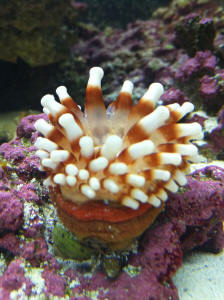
|
|
Polyp identification 8/5/12
Hello there WWM crew. I have had this group of polyps for over a year now
but have watched them grow for years on a friends tank. They do not seem
aggressive as they are growing in a few areas of my tank with no damage to
date. What I would like to know is what are they?
<I do think this/these are some sort of Zoanthids>
Largest polyps are around 3 in, they have buds not tentacles and split
rapidly. Please let me know where they are from, scientific name, common
names, and reference to a care sheet if possible. I have searched many ways
to find out what it is and have shared frags and am sure all of us would
like to know. Thank too very much for your help
<Please read here:
http://www.wetwebmedia.com/zoanthid.htm
and the linked files above. Bob Fenner>
|
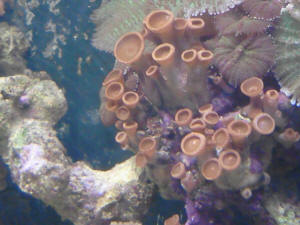
 crop
crop |
|
Strange coral growing on live rock identification
please 1/25/12
<Hello Chris>
I have a 55 gallon reef has been setup for about 2 months I have
been noticing this what seems to be coral growing on my rocks.
It grows rather quickly I was wandering if you
could help me Identify it. Thank you for any help you may offer.
Sorry about the poor picture took it with my phone.
Tank info 55 gallon rectangle 60 pounds live sand 90 pounds LR
all bought at the same store(different days) water parameters are
good all coral are doing well.
<Pic not resolved enough to see much detail but it
appears to be a Sarcophyton of some type. Bob may input
here as well. James (Salty Dog)>
|
|
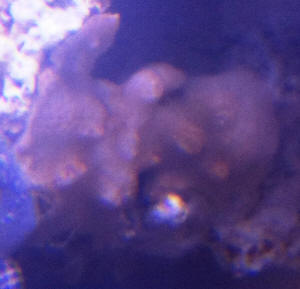 Porites? RMF Porites? RMF
|
Re Strange coral growing on live rock
identification please 1/26/12
Here is another picture still not very good but it's
hard to take with a phone. Thank you for your input this
coral seems to spread and grow very quickly. I'll try
to get a better picture for y'all guys again thank
you.
<Are you referring to the Zoanthid colony in the lower
part of the picture.
If not, our reply remains the same. James (Salty
Dog)>
|
|
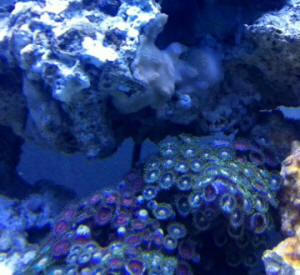
|
|
|
Invert IDs and filter approval? 12/18/11
Hello Everyone,
<Hello Dale>
I'm not even going to guess at pic #4274 spitting cob
webs. But I'm more interested in the possible
stinging Anemone looking thing in the center of pic #5415. It is
a LR hitchhiker in my 8 month old 120g FOWLR. I have IDed
everything else with your site. Much appreciated btw.
<The "stinging anemone" appears to be a
solitary Xenia polyp and under good conditions it should
multiply for you. The other photo appear to be a
Zoanthid, a little too fuzzy to ID accurately.>
About a home-made filter. In my 30g Sump (water level is about
8"), I was thinking of building a 5"x15"
pvc tube capped at bottom with drainage holes all around at lower
3", filled with Arangonite <aragonite> 1-2mm with a
particulate filter on the open top, dumping all my return water
into this. Most water will flow over but would I get any type of
benefit from this?
<Is this going to be easy to clean? Eventually debris
will build up on the aragonite and restrict flow. Sounds like
more trouble than it's worth.
Live rock alone in proper amounts will provide all the nitrifying
bacteria you will require. I'd consider a filter sock if you
wish to trap debris/uneaten food, etc.>
How would anaerobic bacteria get there if I didn't put it in
there?
<The bacteria will find and populate the aragonite.>
I have only 2.5" of sand in my tank and don't really
want a DSB. Thanks Guys!
<You're welcome. James (Salty Dog)>
Dale
|
|
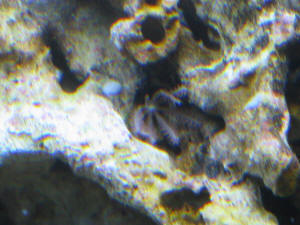 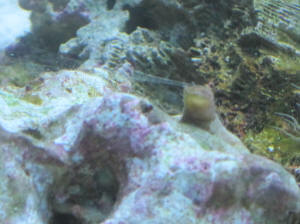
|
|
Corallimorph or Rhodactis... no reading
11/27/11
> Hello,
<Howdy>
> I am not real sure if this site is still up and running
<...>
but I ran across it in my attempt to identify a hitchhiker I have
watched grow from nothing to the size of a silver dollar. I have
searched for months. In the beginning our aquarium store thought
it was an Aiptasia,
<Nah... seems/appears to have a stony skeleton...>
but all my research disagreed with this. I now believe it is a
type of mushroom.
<See above>
It has a mouth, is very fleshy and loves shrimp. However, it did
(or at least I think it did) kill my Pulsing Xenia's. This
site pointed me in the direction of Corallimorph or Rhodactis,
but I still can't confirm.
<... Rhodactis is a genus of/within the Corallimorpharia...
Had you read as we ask... Now do so: http://www.wetwebmedia.com/cnidaria.htm>
> Any assistance in identifying this lil feller would be
greatly
appreciated.
Thank you,
Chianti
<This appears to me to be a young Fungiid. See WWM re. Bob
Fenner>
|
|
 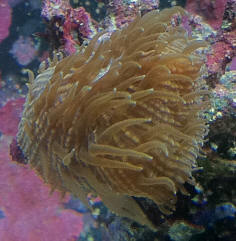
Re: Corallimorph or Rhodactis 11/27/11
I appreciate the time and effort you took to reply to my
email.
(I did scour the internet, and WetWebMedia, including the site
you directed me to, prior to my email.)
I hope you had a great weekend.
<So far, thanks>
Warmly,
Chianti
<Thank you for the vino! BobF>
|
|
Anemone id 9/21/11
Good evening all,
<Hey Gabe>
I purchased an anemone that was a bit bleached but had some
significant bubble-ness. (it was in an outdoor tank, and we were
in a heat wave) It was approximately the size of a quarter.
Anyway, I was able to nurse it back to health, fed it regularly,
and it eventually split. (See picture)
However, it was only marginally larger than a quarter when it
split, and now both are approximately the size of a quarter. (see
picture) I asked my local coral farm (where I bought it from)
about this, and the proprietor said they were of a species of e.
quadricolor
<Mmm>
that has never been categorized, but was a type of pygmy
quadricolor.
<"Dwarf Bubble-tip"...>
He receives them from local reefers who grow them out...he said
they split more commonly than larger btas, and assured me that
they are not majanos...which I didn't mention I was
suspecting.
<Me too>
Have any of you (in your vastly more infinite knowledge than
mine) ever heard of such a variant?
<I have not; though have seen many instances in which
Entacmaea were "dwarfed" by conditions>
As I said, when I first got it, the tentacles looked exactly as
pictures of btas, but since then they are more elongated, but
sometimes have a "lumpy sausage" look at times,
particularly after feeding. Need I be worried about these
anemones?
<Not likely, no>
They have been model citizens to this point, only wandering a
short distance from where they split. Any and all information is
greatly appreciated!
<Don't know more... but perhaps others will chime in on
seeing your pic, message. Do look for it's posting on the
Dailies and ultimately the Anemone ID FAQs on WWM. Bob
Fenner>
|
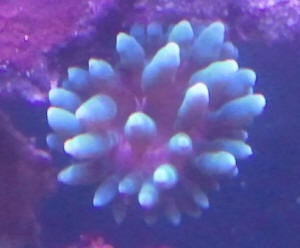 |
|
new anemone cannot find info about
9/17/11
Hello,
<Hi there>
My name is Brandy Pockrus. My husband and I have recently come
into the saltwater hobby and love it. We started with a 29 gal
Bio cube 5 months ago and are now cycling a 150 gal tank. We have
been buying a few extra things this past week, since the 150 will
be finished soon and we can transfer stuff over. Currently we
have the 29 gal Bio-cube without modifications. In the tank is
2" live sand, about 35 lbs live rock, two small-medium
(1.5"-2") maroon clown fish hosting a small bubble tip
anemone, one small blue hippo tang (3.5"), one fire shrimp,
one coral banded shrimp,
<Do keep your eye on the Stenopus... predaceous at
times>
two peppermint shrimp (added for apthasia problem), and one
Goniopora.
<Umm, not easily kept period, and incompatible w/ anemones,
esp. in small volumes>
Lots of coralline algae is present. The bubble tip is not doing
so well.
About a month ago, we had a fire shrimp and he came across the
anemone just after molting. I came home to the shrimp half
sticking out of the anemone. I pulled the shrimp out and the
anemone has not been the same since. He does not eat
well and just looks like poo. LFS does not think it has anything
to do with me pulling out the shrimp, but nothing else has
changed. This is the only negative experience with the tank.
Water conditions, pH-8.0, Ca-380, Phos-0, Nitrate-0,
<Second issue... chemoautotrophs/"corals" need
appreciable NO3, HPO4...>
Nitrite-0, SG-1.0245, NH3-0, KH-179, Temp-80-82F.
So, the real reason I am emailing you is our newest addition as
of yesterday. We were told he is a ball-tipped anemone from
Indonesia who is very rare.
<Mmm, even more problematical to mix anemone species in small
volumes>
According to the LFS guy, who has had saltwater aquariums for 20
years, he has never seen one in person before. I cannot find
anything about this guy. The closest I can come across is
Pseudocornactis sp. and Corallimorpharia.
LFS suggested I send a picture to you to find out more.
I just want to understand the little guy. Is he really as rare as
they say?
<Have not read much re>
Does it need anything special? I was told just to feed him a few
times a week with meaty food and that he should not bother any
inverts. He does not seem to move very much, is there somewhere
special I should place him in the tank?
<I would move all the other Cnidarians ASAP to the new
system...>
Low light, high light, low flow, high flow. I do not want another
poor anemone experience and want to make sure this guy hangs out
for a while.
Thank you for your time
<Mmmm (one last time), I would read re allelopathy, here:
http://wetwebmedia.com/CorlCompArt.htm
and search the site re anemones and their chemical compatibility
in particular. Bob Fenner>
|
 |
|
|

